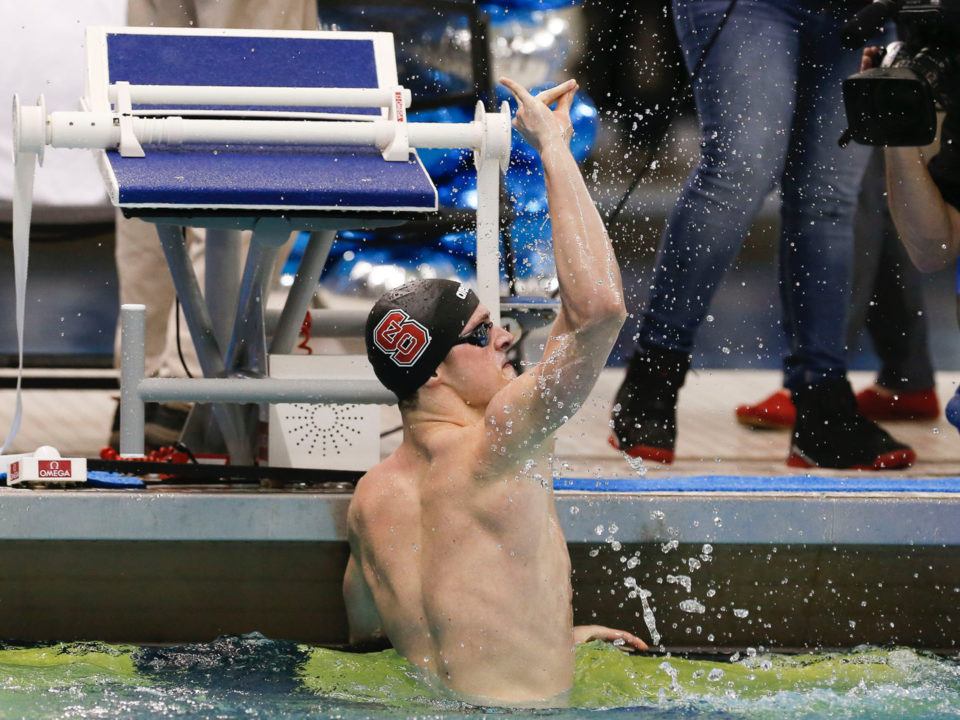TritonWear and SwimSwam bring you the best in swimming race analysis for the 2018 Men’s NCAA DI Swimming and Diving Championships. With the power of TritonWear, you can access 12+ metrics for all athletes simultaneously, display the results in real-time to unlimited screens on deck, and review later in an easy to use interface for monitoring progress and identifying trends over time. See all Tritonwear Race Analysis here.
The men’s 100 back was anyone’s race; the difference between the top and eighth seed was a mere 0.22 seconds. The final results weren’t that much different. Though there was a wider gap between first and eight place, NC State’s Coleman Stewart and Texas’ John Shebat’s battle for gold was determined by a mere 0.01 seconds.
Shebat went into the race hard, clocking in the fastest split on the first lap. He matched Stewart stroke per stroke, producing exactly the same DPS, but at a faster rate, giving him the early lead. However, he was not able to maintain his faster stroke rate past the first lap.
Overall, Shebat went for slower strokes with higher efficiency, while Stewart went for less efficient strokes at a faster rate.
Their individual strategies clearly worked well for them, each using their strengths to their advantage. Shebat’s strokes propelled him farther than Stewart’s but Stewart’s stroke speed was enough for him to swim a faster split in the last 75. However, this was not enough to offset Shebat’s earlier lead, with Stewart still 0.08 seconds behind him on the final turn.
The final 25 made all the difference. For the most part, they were both fairly consistent in their stronger metrics – Shebat’s DPS and Stewart’s stroke rate. However, Shebat’s DPS suffered a significant drop on the last lap. Meanwhile Stewart managed to maintain his stroke rate through to the end, getting him to the wall just one hundredth of a second before Shebat. The outcome of this race may have been different if Shebat had been able to hold onto his DPS, or compensated for the drop with an increased stroke rate.
Another contributing factor to Stewart’s win was the fact that he spent more time underwater off each turn. A lengthy time underwater isn’t necessarily an advantage in itself, unless this time is spent with maximum efficiency. Stewart succeeded in doing this, using his strong underwater dolphin kicks to speed off the walls. Because his strokes aren’t as efficient, the distance he gained off the walls benefitted him more than an early breakout would have.
Takeaways
A key takeaway from this race is the importance of optimizing race strategy to each athlete’s strengths, and staying consistent in this strategy. Shebat and Stewart had different strategies, but they finished a fraction of a second away from each other. What ultimately gave Stewart the advantage was his consistency. Shebat’s fast start gave him a considerable lead, but pacing himself a little better could have reserved enough energy in the end to maintain his stroking power.
To dive into the numbers of each athlete yourself, use the interactive board below to see exactly how they performed across all metrics.
The 2018 NCAA D1 Swimming Championships is almost over, and the final day events surely would not disappoint. Stay tuned for more race analysis!
VISIT THE TRITONWEAR HQ
LIKE TRITONWEAR ON FACEBOOK
FOLLOW TRITONWEAR ON TWITTER
FOLLOW TRITONWEAR ON INSTAGRAM
Swimming analysis is courtesy of Tritonwear, a SwimSwam partner.


Will we get one of these for all of the events?
Didn’t know John Shebat and Townley Haas were the same person. Must be one hell of a swimmer.